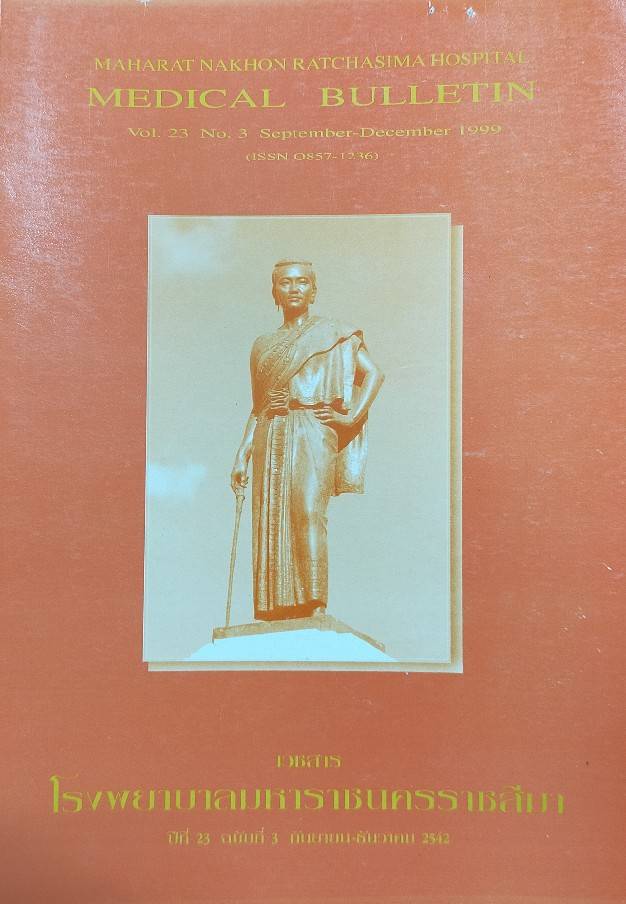Treatment Outcome of Childhood Acute Lymphoblastic Leukemia (ALL) at Maharat Nakhon Ratchasima Hospital
Main Article Content
Abstract
To determine the therapeutic outcome of childhood ALL at Maharat Nakhon Ratchasima Hospital (induction with 3 drugs; prednisolone, vincristine cyclophosphamide or adriamycin), a retrospective study of 40 consecutive patients with first diagnosis ALL during June 1, 1996 to May 31, 1999 was perfomed. Twenty four patients were male and 16 were female. Fifty five percent of the patients were 3-6 years of age. Of 42 patients, 26 were classified as low risk group and 14 were high risk. Overall treatment outcome reved that 62.5% of patients had remission after first course of induction and 85.5% had remisssion affer repeated second course. Thirty percent of remission patients developed relapse, the most common site of relapse was bone marrow (80 .0%), During the study period, 9 patients (26.7%) died. Forty percent of patients are still alive and in remission pha the longest duration of remission was 16 months (3 cases; 17.1%). In conclusion, the current regimen for child at Nakhon Ratchasima Hospital was not effective enough to achieve the good outcome Therefore, the modification of regimen should be considered.
Article Details

This work is licensed under a Creative Commons Attribution-NonCommercial-NoDerivatives 4.0 International License.
References
Nicmeyer CM, Sallan SE. Acute lymphoblastic leukemia. In: Nathan DG, Orkin SH, editors. Hematology of infancy and childhood. Philadelphia: WB Saunders, 1998. p. 1245-85.
Margolin JF, Poplack DG. Acute lymphoblastic leukemia. In: Pizzo PA, Poplack DG, editors. Principle and practice of pediatriconcology. Philadelphia: Lippincott-Raven, 1997. p. 409-62.
Pui CH.Childhood leukemia. N Engl J Med 1995;332:1618-30.
PuiCH, Evan WE,G Gilbert JR. Meeting report: Internal Childhood ALL Workshop: Memphis, TN, 3-4 December 1997. Leukemia 1998;12:1313-8.
Rivera GK, Raimondi SC, Hancock ML, et al. Improved outcome in childhood acute lymphoblastic leukemia with reinforced early treatment and rotational combination chemotherapy. Lancet 1991;337:61-6.
Chessels JM,Bailey C, Richard SM. Intensification of treat ment and survival in all children with lymphoblastic leuke mia: results of UK Medical Research Council Tria UK ALL X. Lancet 1995;345:143-8.
ปรีดา วานิชยเศรษฐกุล, ปัญญา เสกสรร. Treatment outcome of childhood acute Iymphoblastic lenkemia: a Chulalongkorn Hospital study. เวชสารโลหิตวิทยาและเวชศาสตร์บริการโลหิต2537;43:223-41.
บรรเจิด จงเจริญกมล. ผลการรักษา acute lymphoblastic leakemia ในเด็ก. เวชสารโรงพยาบาลมหาราชนครราชสีมา 2538;19:259-67.
Smith M. Toward a more uniform approach to risk classification and treatment assignment for children with acute lymphoblastic leukemia (ALL). Chicago: American Society of Clinical Oncology Educational Book, 1994.p. 1224-30.
Reiter A, Schrappe M, Ludwig WD, et al. Chemotherapy in 998 unselected childhood acute lymphoblastic leukemia patients. Result and conclusive of multicenter trial ALL-BFM 86. Blood 1994;84:3122-33.
Dissaneevate P. Nutritional stutus in acute lymphoblastic leukemia in children and early outcome in the peroid of induction of remission at Sonklanagarind Hospital. สงขลานครินทร์เวชสาร 2537;12:185-6.
Burnett AK, Eden OB. The treatment of acute leukemia. Lancet 1997;349:270-5.
VanDongen JM, Serice T, Grumayer RPE, et al. Prognostic value of minimal residual disease in acute lymphoblastic leukemia in childhood. Lancet 1998;352:1731-8.
Rivera GK, Pinkel D, Simone JV, et al. Treatment of acute lymphoblastic leukemia: 30 years' experience at St. Jude Children's Research Hospital. N Engl J Med 1993;329:1289-95.


